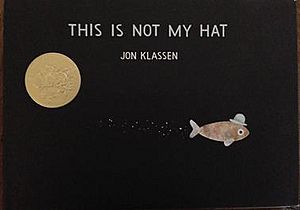This is Not My Hat facts for kids

front cover of unknown edition
|
|
| Author | Jon Klassen |
|---|---|
| Illustrator | Jon Klassen |
| Country | United States |
| Language | English |
| Genre | Children's picture book |
| Publisher | Candlewick Press |
|
Publication date
|
2012 |
| Media type | Print (hardback & paperback) |
| Pages | 40 pp |
| ISBN | 9780763655990 |
| OCLC | 779856963 |
This Is Not My Hat is a 2012 children's picture book by the author and illustrator Jon Klassen. The story is told through the unreliable narration of a little fish, who has stolen a hat from a big fish and how the big fish reacts to the theft. It is a thematic follow-up to I Want My Hat Back and was meant to be a more literal sequel until Klassen took a suggestion to change which animals were in the story. The book was well received by critics who praised its dark or ironic humor which could only be understood by comparing the words of the little fish's narration against the events of the illustrations. In addition to several positive reviews, Klassen won the 2013 Caldecott Medal and the 2014 Kate Greenaway Medal becoming the first book to win both awards. This is Not My Hat was also a commercial success.
Background and publication
Following the success of I Want My Hat Back, Klassen attempted unsuccessfully to tell more stories with the same characters, until the art director at his publisher, Candlewick Press, suggested he try new characters instead. Klassen then switched from mammals to fish. Klassen also felt that this story was more "dramatic" than his earlier work and cited "The Tell-Tale Heart" as a thematic inspiration. For this book he sketched the illustrations in ink before digitizing them and finishing the colors and details electronically.
The book was published on October 9, 2012, and was translated into more than 22 languages. Klassen toured 15 cities in the United States to promote the book. In 2014 an audiobook read by John Keating and accompanied by string instruments to represent the actions of the fish, in a way similar to the orchestration of Peter and the Wolf, was released.
In October of 2019, Candlewick Press released a boxed set featuring This is Not My Hat along with its two companion books (I Want My Hat Back and We Found a Hat), calling it Jon Klassen’s Hat Box.
Plot
A small fish has stolen a hat from a big sleeping fish, and boasts about how easy it will be for him to get away with the theft, because the big fish will not wake up any time soon and maybe not even not notice the missing hat, or know who stole it, or where the small fish is going. Except the big fish does wake up and does notice. The little fish goes to hide in some plants, and is observed by a crab who tells the big fish, who follows the little fish. The little fish remains convinced that the theft will not be found out, but at the end of the story the big fish is wearing the hat.
Writing and illustrations
As Roger Sutton noted in his review of the book for The New York Times, the book can only be understood by weighing the words against the actions depicted in the illustrations, since what happens at the end is not explicitly stated but instead left to the reader to figure out. The small fish, acting as the book's narrator through its monologue, is not only amoral but also "outrageous" in the claims that it will not get caught. The small fish can be seen as either talking to the reader or themselves. The book presents a complex ethical message, with an amoral narrator. This is Not My Hat suggests both not to steal but that if you do steal not to get caught. The reader can both cheer for the little fish's escape and for the little fish to be punished for the theft. The book was part of a trend of authors and illustrators exploring "meta" issues in children's picture books. Critics wondered if the book's success was a sign that young children were able to pick up on ironic humor and if the dark message was a sign of the general American mood.
The book was praised for its design and simplicity. Some reviewers noted Klassen's felicity with using colors like black and brown in the illustrations. The perspective of the illustrations also never changes staying roughly in a medium shot. The feelings of the characters is expressed almost entirely through their eye movements. The illustrations were compared to those of Leo Lionni.


